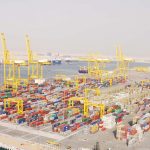West Coast dockworkers and ports are continuing to negotiate on a new contract, Asia-US rates for shipping containers were steady to lower, and inland truck spot and contract rates continue to edge lower, highlighting this week’s logistics update.
The International Longshore & Warehouse Union (ILWU), which represents the 22,000 dockworkers, and the Pacific Maritime Association (PMA), which represents the 29 ports, issued a joint statement on Thursday announcing that negotiations are ongoing and both parties remain hopeful of reaching a new deal soon.
“The parties have agreed not to discuss negotiations in the media as collective bargaining continues,” the groups said in the statement. “Negotiations are not open to the media or the public, and news articles purporting to know what is happening at the bargaining table are speculative at best.”
The statement noted that west coast ports have continued to operate since the previous labour contract expired on 2 July 2022.
The ILWU and PMA said in the statement that the parties have reached tentative agreements on key issues, including health benefits and remain committed to resolving remaining issues as expeditiously as possible.
“Talks are continuing on an ongoing basis until an agreement is reached,” the parties said.
PMA also posted a statement to its website.
“PMA’s negotiations with the ILWU for a new labor contract at the 29 West Coast ports are critically important for the health of jobs, businesses and communities nationwide,” the statement read. “As historic supply chain congestion continues, it is vital that both sides reach agreement without any disruption at the ports. We are proud of our collaboration with the ILWU during this extraordinary period, and hopeful that spirit of cooperation will continue as we pursue a new agreement.”
ASIA-US CONTAINER RATES
Meanwhile, rates for shipping containers from east Asia and China to both US coasts were mixed this week, according to data from online freight shipping marketplace and platform provider Freightos.
Rates to the East Coast rose by 1% despite the onset of the typical ocean freight lull season that follows the Lunar New Year, Judah Levine, head of research at Freightos, said.
The slight increase could be because of lingering congestion at East Coast ports after many shippers shifted their deliveries from West Coast ports last year because of the huge backlogs seen as a result of US consumers buying goods with stimulus money at the onset of COVID-19 lockdown measures.
But the demand appetite from American consumers has shifted back towards services, leading to a decrease in transpacific import volumes.
According to the Drewry World Container Index, the average cost for a 40-foot container fell by 3% this week to just below $1,900/FEU (40-foot equivalent unit).
On the supply side, shipowners are about to begin receiving newbuilds that were ordered at the height of the congestion and tight shipping market.
According to Asia-based consultancy Linerlytica in its latest weekly update, the pace of new deliveries is expected to pick up rapidly in March, especially in the larger segments.
Levine said some observers are anticipating that 25% of the orders will get postponed, and in the meantime, carriers are increasing the number of older vessel demolitions as a way to reduce capacity.
Container ships are relevant to the chemical industry because while most chemicals are liquids and are shipped in tankers, container ships transport polymers such as polyethylene (PE) and polypropylene (PP), which are shipped in pellets.
LIQUID TANKERS
In the liquid tanker market, rates on the Transatlantic Eastbound trade lane are trending lower.
US chemical tanker freight rates assessed by ICIS held mostly steady this week except for slight decreases in spot rates from the US Gulf (USG) to Rotterdam.
Rates were steady from the USG to Latin America, but they have fallen from the highs seen at the end of last year.
RAILROADS
The US National Transportation Safety Board (NTSB) continues to investigate the cause of a Norfolk Southern (NS) train derailment in Ohio on 3 February but said in a preliminary report released on Thursday that a wheel bearing on the 23rd car of the train overheated and failed moments before the derailment.
Railroads are vital to the chemicals industry as chemical railcar loadings represent about 20% of chemical transportation by tonnage in the US, with trucks, barges and pipelines carrying the rest.
In Canada, chemical producers rely on rail to ship more than 70% of their products, with some exclusively using rail.
Meanwhile, US railroads NS, CSX and Union Pacific (UP) announced that they have reached paid sick leave deals with some of the rail worker unions and are urging the other Class I railroads to do the same.
A potential rail worker strike was averted in December after legislation was signed by President Joe Biden, but workers remained unsatisfied with the lack of paid sick days.
TRUCKING
US inland truck spot and contract rates continue to edge lower, according to data from FreightWaves Sonar.
Despite the slight decrease in rates, the American Trucking Associations’ (ATA) advanced seasonally adjusted (SA) For-Hire Truck Tonnage Index rose 0.7% in January, after rising by 1% in December, the ATA said.
“Tonnage has increased nicely in the last couple of months,” said ATA Chief Economist Bob Costello. “I suspect that some of the gain is attributable to capacity coming out of the network, especially those carriers that primarily operate in the spot market and/or bought expensive used equipment in the last couple of years. This would push more freight to contract carriers, which dominate this index.”
Owner-operators are struggling to be profitable in the current environment, according to a recent FreightWaves Research survey.
FreightWaves targeted the survey at owner-operators from 9-17 February and heard from roughly 120 carriers in all.
More than three-quarters of those identified as owner-operators, and another 6.7% answered “no, but I was for part of 2022.”
Only results from current owner-operators were considered in the analysis.
Source: Hellenic Shipping News






